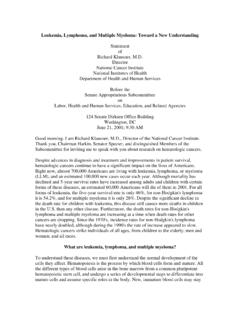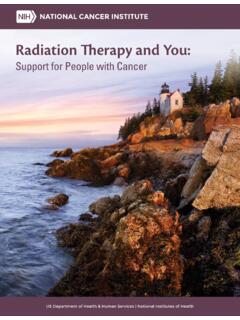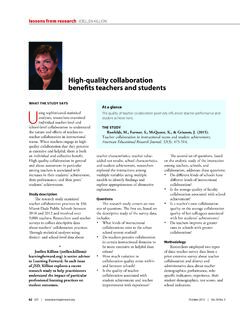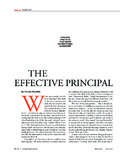Transcription of Collaboration and Team Science Field Guide
1 Collaboration and team Science Field Guide L. Michelle Bennett Howard Gadlin Christophe Marchand Department of Health & Human Services | National Institutes of Health Top Ten Take Aways TRUST. It is almost impossible to imagine a successful Collaboration without trust. Trust provides the foundation for a team . Without trust it is nearly impossible to sustain a Collaboration . VISION. A strong and captivating vision attracts people to the team and provides a foundation for achieving team goals. Shared vision provides a focal point around which a highly functioning team can coalesce. SELF-AWARENESS AND EMOTIONAL INTELLIGENCE. Emotional Intelligence among team members contributes to the effective functioning of research teams. Self awareness gives people greater control over their own emotional reactions to others, improves the quality of their interactions, and helps build other- awareness.
2 LEADERSHIP. Strong collaborative leadership elicits and capitalizes on the team members' strengths and is a critical component of team success. Leadership can be demonstrated by every team member, not just the formal leader(s). MENTORING. Mentoring is an indispensable aspect of successful Collaboration . A. mentor recognizes the strengths of each team member, identifies areas in which newer scientists have the greatest potential to grow, and can help coach people to attain their aspirations. With good mentoring, the development of scientists is synchronous with strengthening team dynamics. PAGE: 2. Collaboration and team Science Field Guide team EVOLUTION AND DYNAMICS. Research teams form and develop through critical stages to achieve their highest potential (Forming, Storming, Norming, Performing). A. positive team dynamic sustains and further strengthens a research team , enabling it to achieve successful outcomes.
3 COMMUNICATION. Effective communication within and outside a research team contributes to effective group functioning. It depends on a safe environment where team members can openly share and discuss new scientific ideas and take research into new, previously unconsidered directions as well as ensure that difficult conversations can take place. RECOGNITION AND SHARING SUCCESS. Individual contributions should be recognized, reviewed, and rewarded in the context of a Collaboration . Recognition and reward of all team members should be done thoughtfully and fairly in the context of the team and the institution. CONFLICT AND DISAGREEMENT. Conflict can be both a resource and a challenge a resource because disagreement can expand thinking, add new knowledge to a complex scientific problem, and stimulate new directions for research. A challenge because if it is not handled skillfully, conflict impedes effective team functioning and stifles scientific advancement.
4 NAVIGATING AND LEVERAGING. NETWORKS AND SYSTEMS. Highly collaborative teams can transcend different organizational structures, extending their reach across and beyond the organization. They often function within the context of multiple and sometimes interconnected systems, and they can help establish strong networks of researchers who together can accomplish more than they could as individuals. PAGE: 3. Collaboration and team Science Field Guide Table of Contents TOP TEN TAKE AWAYS 02. INTRODUCTION 06. CHAPTER 01 | ENGAGING IN team Science 07. This Is Pretty Obvious Stuff CHAPTER 02 | PREPARING YOURSELF FOR team Science 12. The Value of Self-Reflection Understanding Personality Types Giving and Receiving Feedback The Value of Mentorship CHAPTER 03 | LEADING RESEARCH TEAMS 27. Leadership Dimensions CHAPTER 04 | BUILDING A RESEARCH team 37.
5 Launching a team Setting Expectations CHAPTER 05 | TRUST 50. How to Foster Trust among team Members Types of Trust Psychological Safety Creating the Foundation for Trust and Psychological Safety CHAPTER 06 | VISION 58. How to Develop a Shared Vision CHAPTER 07 | COMMUNICATION 64. How to Communicate About Science Promoting Disagreement PAGE: 4. Collaboration and team Science Field Guide CHAPTER 08 | CREDIT AND SHARING 77. How to Give Recognition and Share Credit Organizational Recognition and Reward How to Approach Recognition and Reward Recognition, Review, and Reward Catch 22 for the Tenure-Track Scientist CHAPTER 09 | MANAGING DIFFERENCE 90. How to Harness Diversity in team Science CHAPTER 10 | CONFLICT IS NORMAL 100. Understanding Conflict How to Engage with Conflict CHAPTER 11 | SUSTAINING AND STRENGTHENING THE team 112. How to Strengthen team Dynamics One Bad Apple CHAPTER 12 | NAVIGATING AND LEVERAGING NETWORKS AND SYSTEMS 122.
6 The team as a System: Social Network Analysis CHAPTER 13 | FUN 128. ABOUT THE AUTHORS 130. APPENDIX 132. Collaborative Agreement Questions (Prenup for Scientists). Welcome to My team Letter Template Offer Letter/Pre-Tenure Agreement Template REFERENCES AND RESOURCES 137. PAGE: 5. Collaboration and team Science Field Guide Introduction Collaboration and team Science : A Field Guide was first published in 2010. For nearly a decade, the Field Guide has served as a valuable resource for scientists participating in or leading a research team . It has also been used by those considering becoming involved in or building a research team . Graduate courses designed to focus on or integrate team Science and interdisciplinary research into their learning have used it as a base text, and professional development offices have provided it to trainees to enhance their understanding of working collaboratively.
7 Institutional leaders have used it to help Guide change at an organizational level, shifting research culture from a primary investigator-initiated focus to one that embraces collaborative and efforts that cut across discipline-based departments. The original research foundation for the Field Guide was conducted with scientific teams at the NIH. Since its publication, the authors have had opportunities to travel nationally and internationally to conduct workshops and give lectures, as well as work with and learn from individuals, teams, and organizations. The learning from these experiences is reflected in this second edition. We were honored and humbled by the initial response to the Field Guide . That reaction enabled us to interact with and learn from others and continue collecting practical information as it pertains to Collaboration and team Science .
8 As our learning expanded, it seemed time to update the Field Guide to provide additional information as well as to refine or enhance that which existed. We wish to thank Samantha Levine-Finley for her valuable contribution to the first edition of the Field Guide . We also want to thank Darlene Summers for careful editing of this version of the Field Guide . It is with appreciation for the opportunity to contribute that we have integrated several additional sections as well as resources into this new version. This new version of the Field Guide , as well as the content in the appendixes, can be accessed at PAGE: 6. Collaboration and team Science Field Guide CHAPTER 01. Engaging in team Science Increased specialization of research expertise and methods has made interdependence, joint ownership, and collective responsibility between and among scientists near requirements.
9 These features of team Science may not suit everyone, but given these current trends, most researchers likely will find themselves asked to participate on or lead a research team at some point in their careers. The early 2000's was met with a surge of interest and investment in multi- and inter- disciplinary team Science programs from public agencies and private organizations alike. Today, with modern research methods becoming more specialized and pressing health issues being truly complex, collaborations among scientists trained in different fields have become essential. The Field of inquiry termed the Science -of- team - Science (SciTS) was coined in 2006. This Field encompasses an amalgam of conceptual and methodological strategies aimed at understanding and enhancing the outcomes of large-scale collaborative research and training programs.
10 In 2015, a report commissioned by the National Research Council presented an overview of what has been learned about factors such as team dynamics, team management, and institutional structures and policies that affect large and small Science teams.. (Cooke and Hilton, editors, 2015). There are many types of research teams, each one as dynamic as its team members. Research teams may comprise investigators from the same or different fields. Interdisciplinary teams have members trained in different disciplines bringing their unique expertise together to solve a problem or answer a question. Research teams vary by size, organizational complexity, and geographic scope, ranging from as few as two individuals working together to a vast network of interdependent researchers across many institutions and countries. Research teams have diverse goals spanning scientific discovery, training, clinical translation, public health, and health policy (Stokols, Hall et al.)














